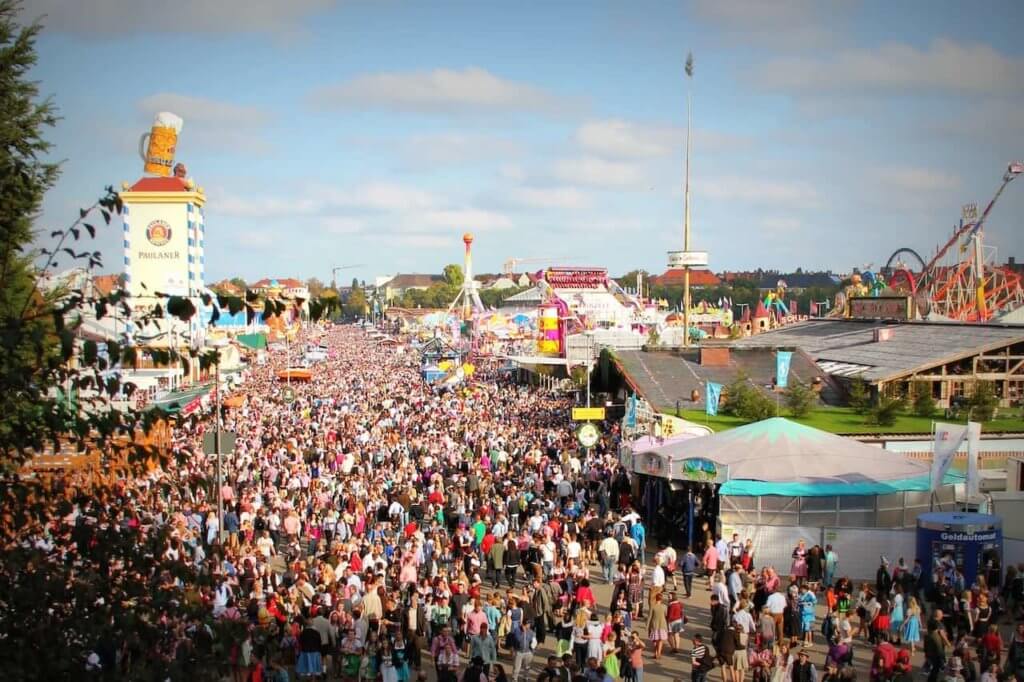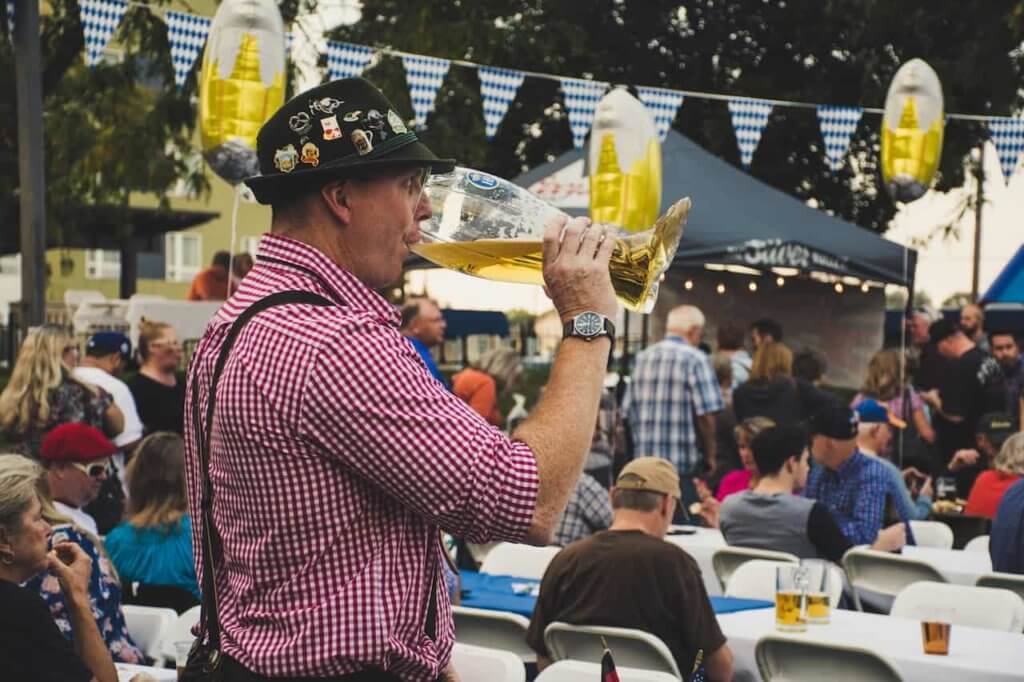- Linguistics
8 Oktoberfest Traditions You Need To Know
September 12, 2022 Renán L. Cuervo
Renán L. CuervoAre you planning to go to Oktoberfest? We’ll tell you everything you need to know about this amazing celebration of German culture, along with essential Oktoberfest traditions you can’t miss!
What is Oktoberfest?
Oktoberfest is the largest Volksfest (people’s festival) in the world. The event happens annually in Munich, Germany, and lasts 16–18 days from mid-September to the first Sunday of October.
After a two–year hiatus due to Covid-19, Oktoberfest makes a comeback on September 17, 2022. And while most people are eager to see the beer tents and traveling funfair, there are other Oktoberfest traditions worth knowing about.
So, if Oktoberfest is on your bucket list, or you simply want to discover more about this amazing German celebration, read on!
Before we begin, don’t forget to check out our Best Way To Learn German article for the most effective tips to master the German language. And remember, the Fluent Forever app and Live Coaching program offer the fastest proven way to learn German.
Download the app and sign up for Coaching here.

I spy with my little eye, beer!
Photo by Manuel Joseph from Pexels
History of Oktoberfest
On October 12, 1810, then Crown Prince Ludwig married Princess Therese of Saxony-Hildburghausen and decided to celebrate with horse races and a public festival.
The following year, the festivity and horse racing returned. And that’s how the tradition known today as Oktoberfest came to be.
Over the years, the now iconic Oktoberfest traditions started to take shape. For example, the carnival aspect of the event appeared towards the middle of the 1800s, while the first large brewery-sponsored tents debuted in 1896.
Today, around 16 million national and international visitors still flock to the original festival grounds – also called Theresienwiese or D’Wiesn in honor of princess Therese’s fields – every year.
Oktoberfest has become one of the most iconic celebrations of Bavarian and German culture. Thousands of Oktoberfest-inspired events pop up outside of this European country, too.

If the shoe fits, drink it!
Photo by Brett Sayles from Pexels
8 classic Oktoberfest traditions you can’t miss
1. O’zapft is!
We’d be remiss to open this list of Oktoberfest traditions any other way.
Since the 1950s, the mayor of Munich has inaugurated the event by tapping a beer keg open using a funky hammer inside the biggest beer tent: the Schottenhamel. At the same time, they yell ‘O’zapft is!’, or “It’s tapped!”, in the Bavarian dialect.
This battlecry lets the other beer tents know that beer can now be officially sold. Naturally, a 12-gun salute follows, aimed in the direction of the Bavaria statue that overlooks the festival grounds.
Oktoberfest has now begun!
2. Oktoberfest beer tents
24 temporary structures varying in size house millions of festival attendees every year. These tents are filled with music, dancing, food, and beer, obviously!
Beer served can only come from six traditional Munich breweries: Augustiner, Paulaner, Spaten-Franziskaner, Löwenbräu, Hacker-Pschorr, and Hofbräu. To do otherwise results in a quick death for the tent owner. I joke!
3. Costume parade
On the first Sunday of Oktoberfest, a 7km (5 mile) procession of more than 7,000 dancers, marching bands, and people dressed in traditional rifle-person costumes prance from Munich’s city center to the festival grounds.
The first parade took place in 1835. Today, it’s one of the main Oktoberfest traditions.
4. The best beer
The beer served in the festival – with the exception of Weißbier – is served in 1-liter (33.8 ounce) steins. Costing around $11 per jug, the quintessential German drink is served, toasted, and downed in German-sized quantities.
For instance, in 2014, the tents served 7.7 million liters (1.7 million gallons) of malty goodness. That’s a lot of Prosting!
Speaking of toasts, if you ever find yourself with a glorious, beer-filled stein in your hand, don’t forget to look people in the eye when you toast . It’s tradition to do so, and bad luck to do otherwise!
To learn more about German drinking etiquette, read about 7 Popular Ways to Say Cheers in German Like a Native Speaker.
5. Fantastic food
Unfortunately, people can’t live exclusively off beer. That’s why scrumptious Bavarian food is served in every tent.
From mouth-watering Bratwursts to the legendary Brezl, the list of Oktoberfest yum-yums is vast. Here are some of the main dishes you should remember:
- Hendl – half or whole spit-roasted chicken)
- Haxn – pork knuckles
- Steckerlfisch – grilled whitefish on a stick
- Bratwurst – traditional German sausage, usually made from pork
- Knoedel –dumplings filled with meat or veggies
- Brotzeit – snacks consisting of meats, cheeses, radishes, and bread
- Brezl – a soft pretzel
6. The festival grounds
D’Wiesn or Theresienwiese holds not only beer and food, but also carnival-style celebrations and rides. Just mind your beer intake before you get on a ride!
7. Bavarian music
Traditional Bavarian music, or Schlager, will merrily yodel out of most of the festival’s tents. The songs are usually traditional German folk songs, but they will throw in modern numbers to keep with the times!
An Oktoberfest-certified classic, the Ein Prosit song is one of those Oktoberfest traditions that you’ll hear constantly. Here’s what it sounds like.
8. The Chicken dance
Lastly, where there’s music, there’s dancing. Every year for the last 20 years, the Bavaria statue has witnessed millions of people “Chicken Dance” their worries away.
Set to Der Ententanz , or “Dance Little Bird,” this dance is one of the main reasons why people put their steins down during Oktoberfest. Doing as the chickens do is easy:
First, make a chicken beak with both of your hands in front of your mouth and cluck. Next, with arms akimbo, flap your elbows four times in a row.
Afterwards, stretch your arms outwards with your palms facing down, bend your knees, and flap your human wings while you wiggle back and forth. Again, repeat this four times.
Lastly, stand up straight and clap four times while you spin around. Rinse and repeat! Congratulations, you can now “Chicken Dance.”
Ready to learn German?
We hope you enjoyed this article and are ready to hit Oktoberfest this year or the next. Make sure to visit our blog for more German-related articles, like the 101 German Travel Phrases Every Backpacker Should Know.
Don’t forget that the Fluent Forever app and Live Coaching program are your best bet to learn German fast. Get started today!
- culture
- German
- German sounds
- language learning